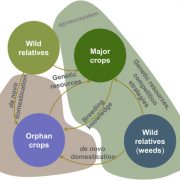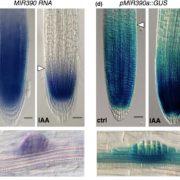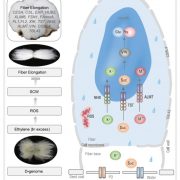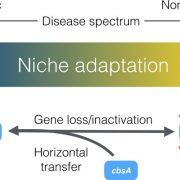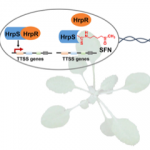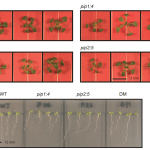Phylogenomic evidence for reductive evolution of stomata (Curr. Biol.)
 Colonization of the terrestrial environment by land plants (embryophytes), a monophyletic clade that evolved from freshwater streptophyte algae, forever changed Earth by transforming biogeochemical cycles. The evolution of stomata was a key adaptation that allowed the colonization of terra firma. Present in most land plants, stomata control the passage of carbon dioxide and water vapor, thus providing plants with a coping mechanism against arid and fluctuating conditions. The origin and ancestral function of stomata are obscure because of stomata-bearing and -lacking lineages and diversity in their morphology and function. By making use of new plant genomes and data from the 1KP project, Harris et al. sought to unravel the phylogeny of land plant and through it resolve the evolutionary history of stomatal development and function. By analyzing single-copy orthologs of 162 Viridiplantae genomes the authors determined that bryophytes were monophyletic and sister to tracheophytes, suggesting that the common ancestor of land plants already possessed stomata, with secondary loss of these in liverworts and some mosses. Subsequent presence/absence analyses of genes involved in stomata development and function confirmed this, as several genes essential for these processes were present in the common ancestor of embryophytes, whereas many of them were later lost in bryophytes. These results confirm bryophyte monophyly and shed light on stomata origin, suggesting that the ancestor of land plants possessed stomata, while bryophytes underwent reductive evolution probably due to loss of key developmental and functional regulators, with liverworts entirely losing stomata and later evolving liverwort-specific air pores. (Summary by Jesus Leon @jesussaur) Curr. Biol. 10.1016/j.cub.2020.03.048
Colonization of the terrestrial environment by land plants (embryophytes), a monophyletic clade that evolved from freshwater streptophyte algae, forever changed Earth by transforming biogeochemical cycles. The evolution of stomata was a key adaptation that allowed the colonization of terra firma. Present in most land plants, stomata control the passage of carbon dioxide and water vapor, thus providing plants with a coping mechanism against arid and fluctuating conditions. The origin and ancestral function of stomata are obscure because of stomata-bearing and -lacking lineages and diversity in their morphology and function. By making use of new plant genomes and data from the 1KP project, Harris et al. sought to unravel the phylogeny of land plant and through it resolve the evolutionary history of stomatal development and function. By analyzing single-copy orthologs of 162 Viridiplantae genomes the authors determined that bryophytes were monophyletic and sister to tracheophytes, suggesting that the common ancestor of land plants already possessed stomata, with secondary loss of these in liverworts and some mosses. Subsequent presence/absence analyses of genes involved in stomata development and function confirmed this, as several genes essential for these processes were present in the common ancestor of embryophytes, whereas many of them were later lost in bryophytes. These results confirm bryophyte monophyly and shed light on stomata origin, suggesting that the ancestor of land plants possessed stomata, while bryophytes underwent reductive evolution probably due to loss of key developmental and functional regulators, with liverworts entirely losing stomata and later evolving liverwort-specific air pores. (Summary by Jesus Leon @jesussaur) Curr. Biol. 10.1016/j.cub.2020.03.048
[altmetric doi=”10.1016/j.cub.2020.03.048″ details=”right” float=”right”]


